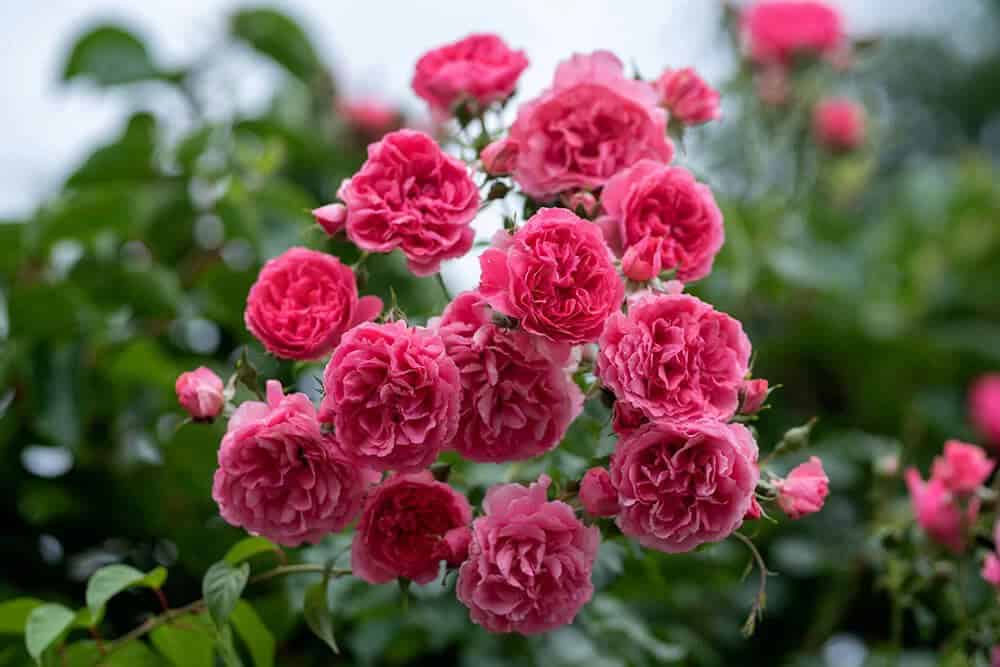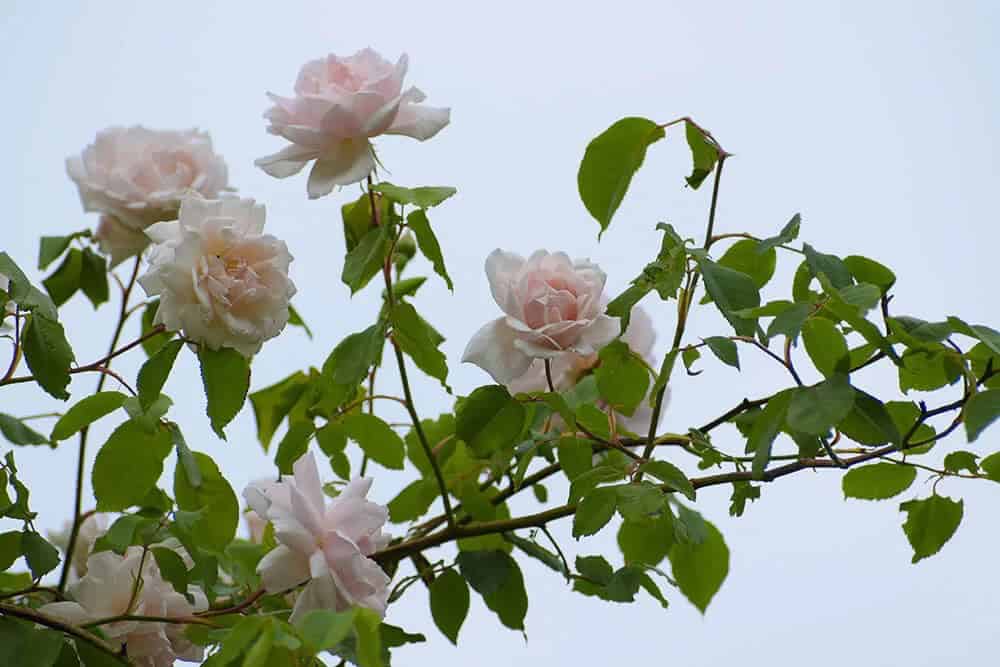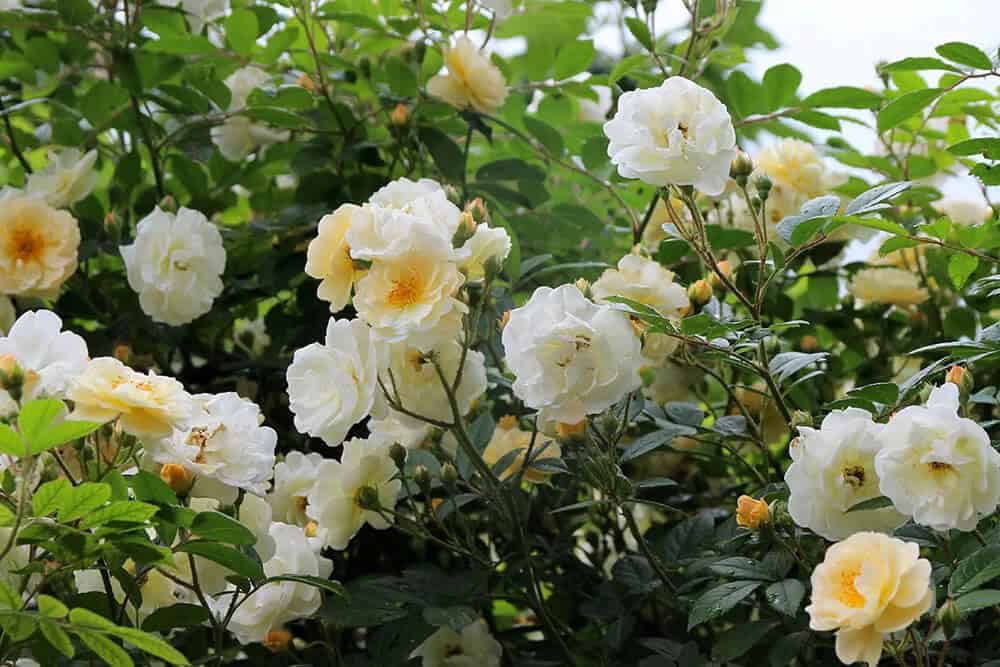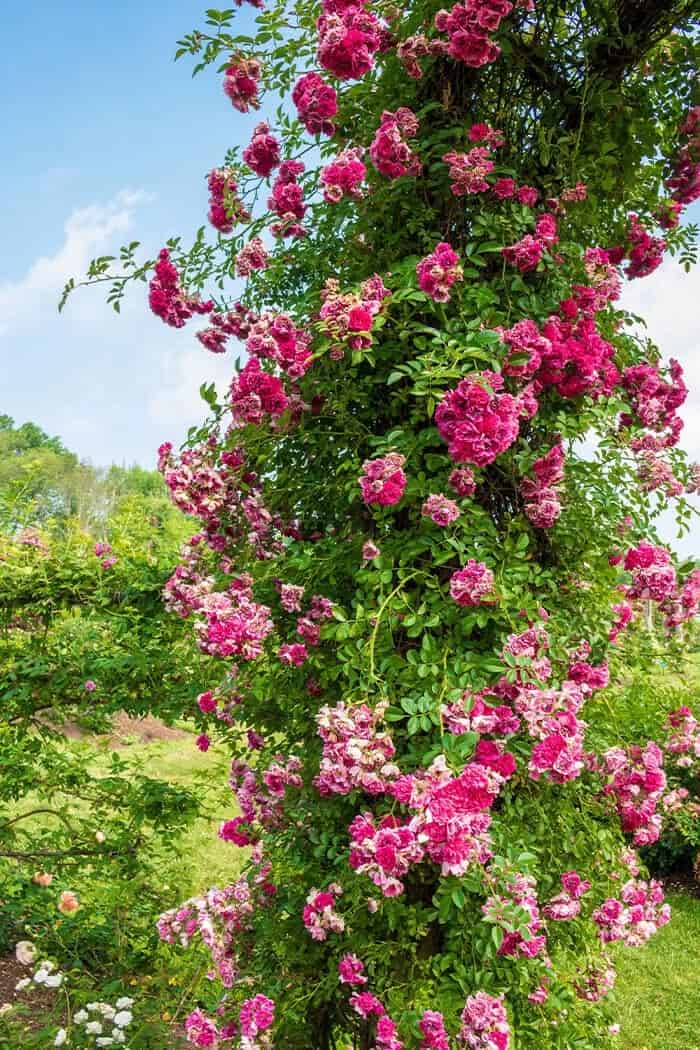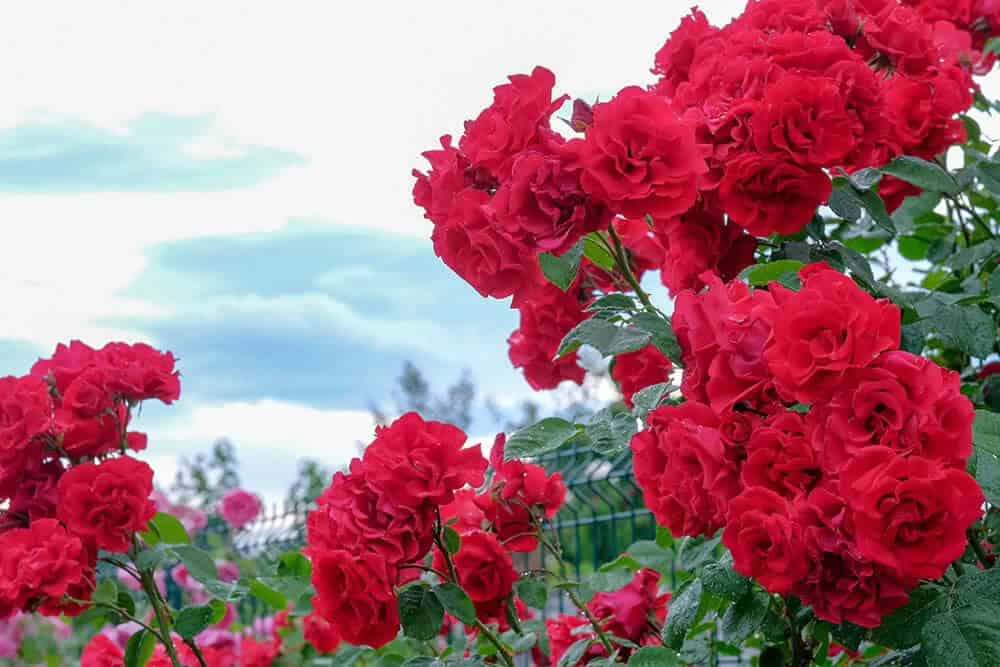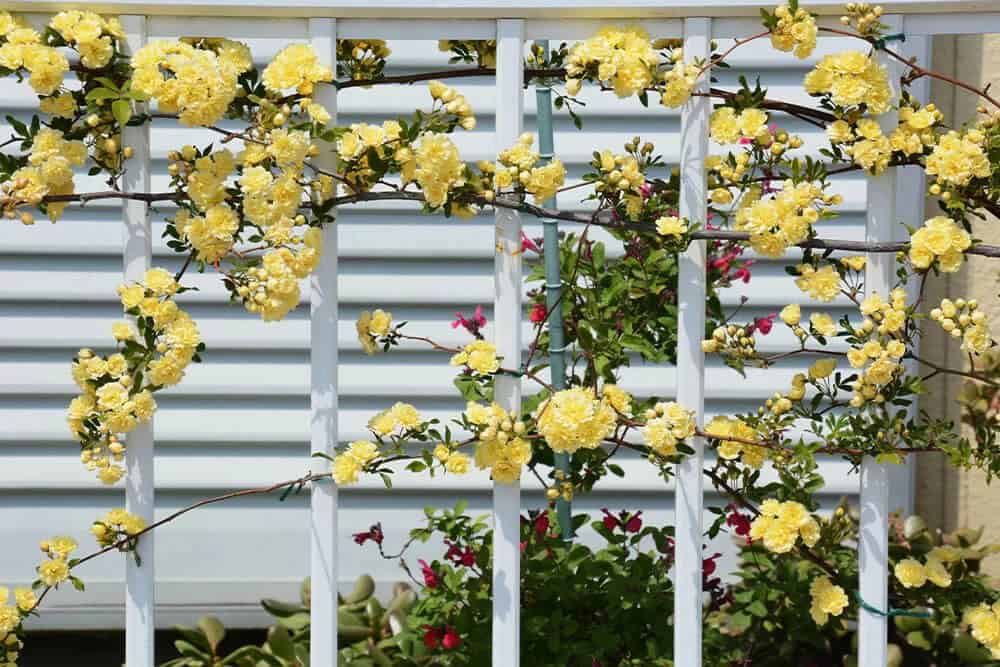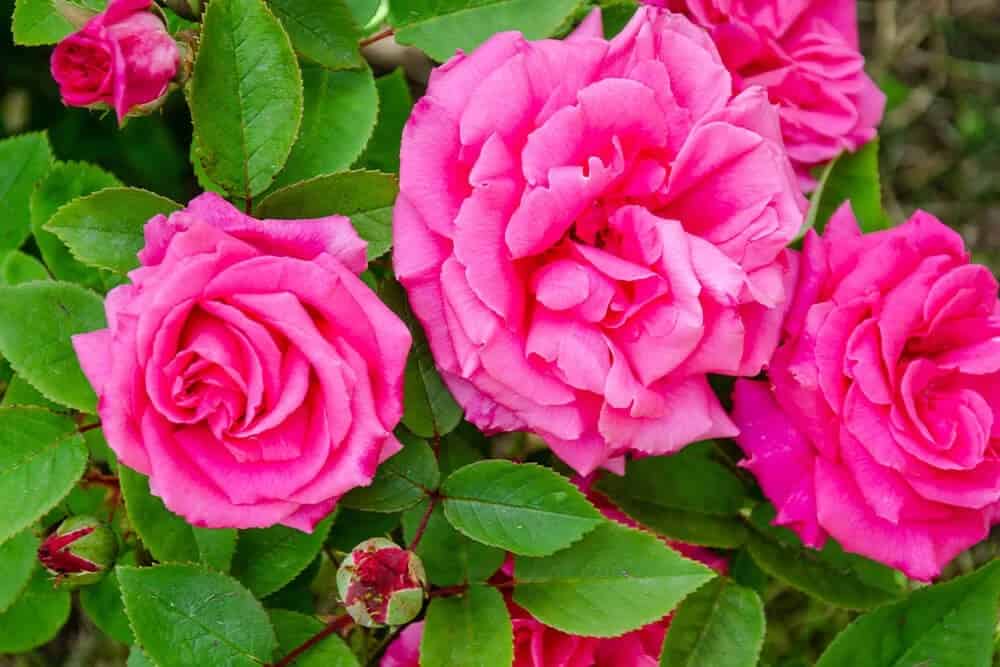Climbing roses bring unparalleled elegance and vertical interest to any garden. To thrive, they require a sturdy structure like a wall, trellis, tree, or pergola to scale. The sheer diversity among climbing rose varieties is truly astounding, with differences in size, shape, fragrance, color, and hardiness.
This variability means that every imaginable rose flower form can be found, from the classic 5-petalled flat blooms to show-stopping pompoms and intricately quartered creations featuring dozens of layered petals. With growth heights ranging from modest 3 feet to majestic 20 feet, climbing roses are an ideal choice for cottage-themed gardens, rose gardens, or serving as a striking focal point in any garden design.
Key Takeaways
While climbing roses don’t possess self-clinging properties like other plants, they still require a supporting structure to thrive. Some varieties rely on their thorns for traction, although training and securing them to a desired location is often necessary. The versatility of climbing roses extends beyond their blooms, which come in an array of shapes, colors, and sizes. What’s more, these roses are adaptable to almost every region, with some hardy enough to flourish even in USDA zone 2.
As a result, they can elevate any garden to new heights, making them a truly spectacular feature.
10 Types of Climbing Roses to Raise Your Garden to Luxurious Heights
Honeymoon Arborose Climbing Rose (Rosa ‘Arborose Honeymoon’)
With its repeat blooming habit, Honeymoon Arborose Climbing Rose fills your garden with a fresh and delicate rose fragrance throughout the entire summer. The romantic blooms are truly impressive, featuring large clusters of cup-shaped flowers that measure 3 inches in diameter. Each blossom boasts a blush-colored center and an astonishing 50+ petals, creating a luxurious and opulent display. One of its standout features is its ease of growth, making it perfect for gardeners of all levels.
Additionally, this climbing rose is exceptionally disease-resistant, ensuring healthy foliage with thick, glossy dark green leaves on sturdy canes. As it grows vigorously, Honeymoon Arborose Climbing Rose becomes an even more rewarding climber, producing bigger and better blooms year after year. Although it may surprise you with blooms in its first year, it’s hardy enough to thrive in USDA zones 5-9, reaching heights of 7 feet tall and spreading 4 feet wide.
Laguna Arborose Climbing Rose (Rosa ‘Arborose Laguna’)
The Laguna Arborose Climbing Rose is a stunning variety that boasts deep pink, quartered blossoms in clusters of six to eight, which bloom repeatedly from late spring to late fall. These highly fragrant flowers emit an intoxicating scent reminiscent of old-world roses and lemongrass, making them a treat for the senses. This rose was bred by Kordes of Germany and has earned notable awards, including the Baden-Baden Silver Medal in 2007 and the Geneva Silver Medal in 2007.
As a medium-height climbing rose, Laguna Arborose Climbing Rose reaches heights of 8 to 10 feet, making it well-suited for training over a rose arbor or fence. Its soft canes and dense, dark green foliage grow healthily in USDA hardiness zones 5 to 9, ensuring this rose thrives in many climates.
Eden Climbing Rose (Rosa Eden)
The Eden Climbing Rose, also known as Pierre-de-Ronsard rose, boasts the distinction of being the world’s favorite and best-selling climbing rose. Its impressive reputation stems from its exceptional qualities, including large, double, cupped blooms with 60-100 petals that unfurl in a profusion of pastel pinks, creams, and yellows throughout the growing season. These lightly scented flowers, measuring 4 ½ inches in diameter, are sure to captivate with their delicate hues.
This vigorous climbing rose is notable for its repeat blooms, which appear from early spring through fall. Reaching heights of 8-10 feet, Eden Climbing Rose features dense, glossy green leaves and a remarkable disease-resistance. Its versatility allows it to thrive in USDA zones 5-10, making it an ideal choice for training on pillars, obelisks, fences, trellises, or gazebos.
Climbing Rose “Madame Alfred Carriére” (Rosa “Madame Alfred Carriére”)
The Madame Alfred Carriére Climbing Rose is renowned for its intoxicatingly sweet fragrance, reminiscent of luscious fruits. This repeat bloomer has been a garden showstopper since its introduction in 1879. Its large, globe-shaped blooms boast an impressive 40+ petals, presenting a soft pearl-pink hue that gradually transitions to a creamy white as they mature.
With only minimal thorn presence, the nearly thornless canes of this Noisette rose type can thrive in partial shade and tolerate some drought. The robust growth habit produces a striking display with bushy, upright foliage and attractive stems. As a fast-growing heirloom rose, Madame Alfred Carriére is well-suited to cover garden walls, fences, or structures, reaching heights of up to 10 feet tall and 8 feet wide under optimal conditions.
In ideal settings, this climbing rose can stretch up to an impressive 25 feet in height. While not exceptionally cold-hardy, Madame Alfred Carriére Climbing Rose excels in USDA hardiness zones 6 to 11.
Climbing Rose “Ghislaine de Féligonde” (Rosa “Ghislaine de Féligonde”)
Ghislaine de Féligonde Climbing Rose is a charming and versatile variety that boasts an impressive display of repeat-flowering orange blossoms. As the blooms progress, they subtly change color, transitioning from pale apricot to peach, pink, and finally translucent white. The delicate petals release a sweet, musky fragrance, adding an extra layer of allure to this already captivating rose.
This climbing rambler can be trained to grow upwards on supports or pruned into a tall shrub, reaching lengths of up to 12 feet. Its almost thornless branches are moderately slow-growing and hardy in USDA zones 5-10. The small but abundant blooms make this variety an attractive option for rose enthusiasts.
Climbing Rose “Dorothy Perkins” (Rosa “Dorothy Perkins”)
What sets Dorothy Perkins Rambling Rose apart is its stunning display of double-matt pink flowers, which bloom en masse in early summer. This popular rose variety was introduced in 1861 and can grow up to 15-18 feet tall, making it perfect for large arches, walls, or fences. Not only does it make a beautiful statement piece, but it also has the unique ability to be trained into a tree form. The flowers themselves boast a subtle rose scent and are hardy in USDA zones 5-10.
While Dorothy Perkins is a gorgeous addition to any garden, it’s worth noting that it can be prone to mildew. Fortunately, a newer version called Super Dorothy, developed in 1986, offers improved disease resistance and repeat blooms throughout late spring and fall.
Paul’s Scarlet Climber (Rosa Paul’s Scarlet Climber)
While many might search for the perfect cupped red rose, others may find themselves enamored with a sight that’s just as lovely: a profusion of vibrant red roses blooming effortlessly on sturdy climbing stems. Paul’s Scarlet Climber, with its subtle fragrance and moderate bloom size, seems to have stepped straight out of a whimsical tale. This old-fashioned rose, bred in 1876, is well-suited for adorning walls or fences, or growing over doorways or arches.
Reaching 12 to 15 feet in height, the medium-sized Paul’s Scarlet Climber boasts semi-double flowers clustered within large, elegantly framed bunches, all surrounded by lush, glossy green foliage. While it may not be the most robust choice where powdery mildew is a concern, as it does exhibit some susceptibility, this vigorous grower proves hardy in USDA zones 6 to 9.
Red Climbing Rose “Amadeus” (Rosa “Amadeus”)
The Climbing Rose ‘Amadeus’ is a standout variety, boasting massive clusters of 5-7 dark red blooms that are simply breathtaking. What’s more, this rose boasts excellent disease resistance, making it an ideal choice for gardeners who prioritize healthy growth. Hardy in USDA zones 5-9, the ‘Amadeus’ can thrive in a range of conditions. Its compact stature – reaching only 8 feet tall and 3 feet wide – makes it well-suited to grow on fences or train into a lush privacy screen.
With its dark green, glossy foliage, this rose is less likely to fall prey to common issues like black spot or powdery mildew, making it a top choice for gardeners seeking a low-maintenance yet stunning addition to their outdoor spaces.
Lady Banks Rose (Rosa banksiae)
Lady Banks Rose, a stunning heirloom variety from 1824, boasts a remarkable ability to grow up to 20 feet tall when trained on sturdy support. Its nearly thornless stems make it an excellent choice for climbing structures of various styles. This rambling rose is renowned for its grand display of hundreds of miniature yellow flowers that bloom simultaneously each spring, earning it the prestigious Award of Garden Merit from the Royal Horticultural Society.
As a vigorous and fast-growing climber, Lady Banks Rose also exhibits remarkable drought resistance and hardiness in USDA zones 6 to 9, making it an ideal choice for gardeners seeking low-maintenance beauty.
Climbing Rose “Zepherine Drohin” (Rosa “Zepherine Drohin”)
The Climbing Rose ‘Zephirine Droughin’ is a timeless favorite, boasting nearly constant blooms of deep rose pink flowers with an intoxicating fruity fragrance. Introduced in 1868, this charming rose has been delighting gardeners for over a century. The showy 4-inch blooms appear in profuse flushes throughout the growing season, making it a standout in any garden. Once established, the thornless stems can grow up to 10-15 feet tall, providing a stunning display of color and scent.
While slightly more prone to disease, this fragrant bourbon rose is surprisingly resilient, thriving in USDA zones 6-10 in full sun to part shade and tolerating most soil types.
Frequently Asked Questions About Types of Climbing Roses
What is the difference between a climbing rose, and a rambling rose?
While the terms ‘climbing rose’ and ‘rambling rose’ are often used interchangeably, there is a subtle distinction between the two. Essentially, breeding and ancestry play a significant role in determining whether a rose is classified as climbing or rambling. A key difference lies in the blooming pattern: climbing roses typically produce flowers repeatedly throughout the growing season, whereas rambling roses tend to have one main flowering period in midsummer.
Furthermore, climbing roses are often characterized by larger blooms, whereas rambling roses feature clusters of smaller blooms. Interestingly, rambling roses are known for their more flexible growth habit, making them slightly easier to train and shape.
What is the most popular climbing rose?
The Eden Climbing Rose has earned a reputation as the world’s most beloved variety. Its impressive sales figures across multiple prominent rose producers make it a top choice among enthusiasts. This exceptional climbing rose is known for its generous blooms, which appear early in the season and continue to bloom reliably until frost sets in.
Another highly sought-after contender is the Zepherine Drouhin Climbing Rose, renowned for its large, 4-inch deep rose-pink flowers that emit a sweet fragrance. These stunning blooms appear in flushes throughout the growing season, making it a standout among climbing roses.
What type of rose is climbing?
Climbing roses are characterized by their long, pliable stems that have been bred for their ability to ascend structures. Unlike plants like beans or peas that produce self-clinging tendrils, roses rely on human assistance to climb. With a little guidance through pruning, tying, and training, these blooms can be coaxed onto various supports such as walls, fences, arches, trellises, trees, pergolas, and gazebos.
By providing the necessary support and nurturing, you can direct the growth of your climbing rose, allowing it to flourish in a location of your choice.
What is the hardiest climbing rose?
While the list above highlights some remarkable climbing roses, there are indeed others that are equally impressive in their hardiness. These resilient varieties have been bred from Canadian Roses and can thrive in as low as USDA zones 2, making them suitable for even the most challenging climates. Conversely, they also exhibit adaptability to warmer temperatures, with some varieties thriving in zones 9 or higher.
Two notable examples include ‘John Davis’, which boasts candy-pink, old-fashioned blooms reminiscent of a bygone era, and ‘Long John Silver’, featuring large, fully double, white flowers emitting a fragrant scent akin to gardenias and myrrh. These hardy climbing roses offer a unique combination of durability and charm, making them a compelling choice for any rose enthusiast.
What is the best-smelling climbing rose?
While our previous list showcased several impressive climbing roses, one standout contender for the best-smelling variety is the Zéphirine Drouhin. This exceptional rose boasts an intense fragrance that sets it apart from other contenders. Additionally, The Pilgrim offers a unique combination of beauty and scent, featuring pure yellow blooms with a subtle tea and myrrh aroma.
Tess of the d’Urbervilles rounds out our list, boasting 4-inch flowers infused with a fruity, old-rose fragrance reminiscent of a bygone era. Finally, Kiss Me Kate from the Arborose collection earns its place on this list due to its potent, heady scent that’s sure to delight.
10 Incredible Types of Climbing Roses for a Whimsical Cottage-Themed Garden
Transform your garden’s vertical space with the breathtaking beauty of climbing roses. These versatile blooms thrive when provided with a sturdy structure like a wall, trellis, tree, or pergola to wrap themselves around. The wonderful world of roses is even more wondrous when it comes to climbing roses, which boast an astonishing array of sizes, forms, fragrances, colors, and hardiness levels.
Whether you’re looking for blooms in every shape imaginable or a dramatic display of color and texture, climbing roses can elevate your garden’s style from ordinary to extraordinary. With heights ranging from 3 to 20 feet tall, the possibilities are endless.

